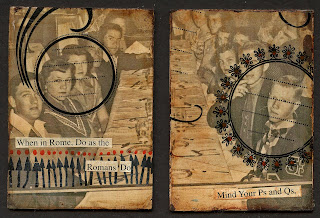 |
| The journal is built on a Moleskin Japanese album (5 x 8.5), which has 48 folded zigzag pages. That first page, way over on the left? Well, that would turn out to be the Glitch. |
My design inspirations come from what I think Italy will feel like when I get there. Over the base prep I've been making patterns in thickly brushed gesso, then layering on glazes of phthalo turquoise (and various Madonna blues), yellow ochre, siennas raw and burnt, and burnt umber. Vintage European postcards and other materials from my various collections make handy lift-up trap doors and pockets for tags.
The bad news is that despite all my progress today, at day's end I find myself back at the beginning. My days' ends often work out like that, and I am learning that this is not necessarily a bad thing. For refreshment for the work ahead, I call upon a brooding Malbec.
| There was no chianti in the wine rack, so I thought a brooding Malbec would be a decent substitute. |
My last task of the day is not to glory in the progress of my work but to detach the first page in the journal in order to add width. I am doing this because the first page won't even pretend to approach flat when opened, and I just can't stand that. So I slice apart the front page from its neighbor and in so doing liberate the entire page block from the book. I fold over some paper from the second page onto the first, make a new crease, and lay on a ton of packing tape for reinforcement. Geez, it looks awkward. Luckily, I remember that I have a couple of scalloped metal page edges in one of my bins. They prove to be workable and hide most of the packing tape. I'll use one metal edge on the first page, and, for balance, one on the last page. I know that there will be physical and design repercussions from doing this.
The first repercussion is that the old Italian postcard of the Madonna now sits way too close to the gutter. I will have to rip out the postcard. Such are the dangers of working with original materials.
| The metal page edges are made by 7 Gypsies and are nice and heavy—the page edge looks okay and as a bonus it weighs down the page to keep it open. |
Because I used paper from the second page to widen the first page, another issue is the new narrow width of the second page. The metal edge draws attention to this. I see that I am going to have to lean heavily on the third page to balance out the second page. I fashion a tag holder and insert one of the tags I've already made. The visual weight helps a lot, plus the tag will give me more surface to write upon when I am in Italy.
Back to the Madonna. I realize that I actually like the rip in the postcard. Venice is sinking, frescos are deteriorating, we are marching toward the grave, Mother Earth is roaring--at least here on the East Coast of the United States--with an earthquake past and a hurricane future. A brooding glass of wine indeed! Yet I have the luxury of piecing together a Madonna. And for pure serendipity, there is the way the infant's feet point the eye to my little solvent-transfer line of text, the one that says, upside down of course (because that is sometimes the way I am), "introducing myself."
| Still life with Madonna and Malbec |
And that is what I did last night. Thanks for listening.













